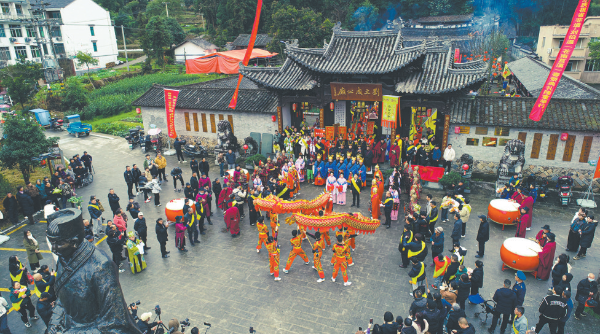Cangnan Juxi creates a feast of Liu Bowen culture
时间:2024-03-15 15:38:54 来源 : DiscoverWenzhou 作者 : ZhongXin
With the beautiful music of Jiaoye Guqin (ancient musical instrument in the shape of a banana leaf), a promised“cultural feast” unfolded gracefully. On February 24th, the Intangible Cultural Heritage Tourism Festival—the Spring Fete for Liu Bowen took center stage in Liuji Cultural Park, situated in the heart of Juxi Town, Cangnan County. The event is in memory of Liu Ji (July 1, 1311 - May 16, 1375), alias Liu Qingtian and styled Bowen, a military strategist, politician, and litterateur in the late Yuan(1206-1368) and early Ming (1368- 1644) Dynasties, and also a founding father of the Ming Dynasty.

On that day, the square was abuzz with tourists, all eager to witness the captivating performances that filled the air with jubilation. In addition to appreciating numerous intangible heritages such as Woodcarving, Sugar Painting, Dyeing Paper Cutting, and Hook Embroidery, visitors were invited to participate in solving lantern riddles, celebrating the Lantern Festival of the Year of Loong, and indulging in local delicacies like Yellow Rice Cake, Jiu Ceng Gao(9-layer rice cake), and the renowned four specialties of Juxi (rice fish, dried fish, dried vegetables and smoked dried rabbits). All together offered a deep immersion into the enchanting traditions and flavors of the region.
The Spring and Autumn Fetes for Liu Bowen, a storied event with over 500 years of history, stands as the epitome of Juxi Town’s historical and cultural identity. Renowned as the foremost family sacrifice in southern Zhejiang, it holds a special place in the provincial intangible heritage project list. The festival is marked by two significant occasions each year with the same procedure: the Lantern Festival on the fifteenth day of the first lunar month and the Mid-Autumn Festival on the fifteenth day of the eighth lunar month.
Adding to the festival’s elegance was a collection of Guqin performances, highlighting the intricate connection between Liu Bowen and Jiaoye Guqin. Ancient music books from the Ming (1368 to 1644) and Qing(1636 to 1912) Dynasties all attest to Liu Bowen’s pivotal role in the development of Jiaoye Guqin, often referring to it as“Liu Bowen Qin” in his honor. Furthermore, Liu Bowen’s Guqin music composition Night Conversations at the Traveller's Window has been passed down through the ages, serving as a testament to his musical genius.
Liu Xiajing, head of Cangnan Liuji Cultural Park, said that the event marks a significant fete for the Liu family. Notably, last year, Liuji Temple in Juxi was included in the eighth batch of provincial-level cultural relics protection units declared by the Zhejiang Provincial People’s Government. This temple, which falls under the category of ancient building protection, served as the backdrop for a monument unveiling ceremony during the spring sacrifice. It is worth mentioning that in the temple, there is Bowen Forest of Steles, which records poems, fables, maxims, and renowned quotes from Liu Ji. Most of these inscriptions are drawn from the Sincerity Bowen Collection. Additionally, some inscriptions are excerpts from imperial edicts and mandates issued by Zhu Yuanzhang, the founding emperor of the Ming Dynasty, as well as poems from cultural luminaries of the Ming and Qing Dynasties praising Liu Ji. In total, there are 200 carved monuments, including works from three presidents of the Chinese Calligraphers Association and renowned artists. The four Chinese characters“伯温碑林”(meaning Bowen Forest of Steles) was inscribed by the renowned painter and calligrapher Liu Danzhai, and the preface was written by Zhou Qun, a doctoral supervisor at Nanjing University, and inscribed by Lin Jiandan. Thanks to Mr. Lin Jiandan and Mr. Zhang Suo, the Bowen Forest of Steles was completed successfully.
Liu Ji Temple in Juxi, also known as Liu Wencheng Temple, was constructed by Liu Qixian, the sixth-generation descendant of Liu Ji, in the seventh year of Hongzhi in the Ming Dynasty (1494). Before that, Liu Qixian and his family were living in Nantian of Wencheng County.
Facing south with its back to the north, Liu Ji Temple is a Ming Dynasty style building with cornices and arch of wooden architecture, grey tiles and red columns. What’s more, it is surrounded by the mountains and the water. Upon entering the spacious main hall, one is greeted by the statue of Liu Ji, donned in regal attire, his grandeur and dignity exuding from every detail. To either side, statues of his eldest son Liu Lian and second son Liu Jing stand, each a testament to the dynasty’s lineage.The temple walls are adorned with plaques and couplets, all written by illustrious figures, their brushstrokes vibrant and words filled with charm. Notably, the collection of works by over 30 renowned artists, including Sha Menghai, Zhou Gucheng, Wang Juchang, Fang Jiekan, Xie Zhiliu, and Su Yuanlei, amassed during the temple’s restoration in 1983, often draw visitors to pause and admire. Some of these inscriptions, poems and couplets not only encapsulate Liu Ji’s moral achievements but also evoke profound admiration for him.
In addition to the grandiose ceremony, Juxi Town also hosted a signing event aimed at attracting investments and enterprises. As a result, four enterprises signed to establish their presence in the town. Volunteers involved in this endeavor assisted the local government in promoting investment opportunities, leveraging the cohesion and appeal derived from shared clans, while simultaneously contributing cultural momentum towards rural revitalization and sustainable development.(ZhongXin)

8017ba29-05e8-4281-a820-7567d396be42.jpg)
dba0fcf6-c53e-4f5b-b1cf-556dc8c16e15.png)